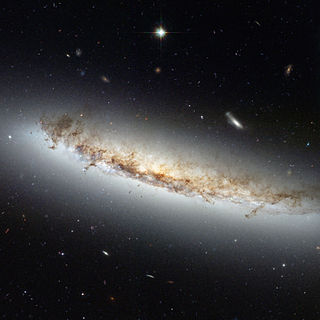
Ram pressure is a pressure exerted on a body moving through a fluid medium, caused by relative bulk motion of the fluid rather than random thermal motion. It causes a drag force to be exerted on the body. Ram pressure is given in tensor form as
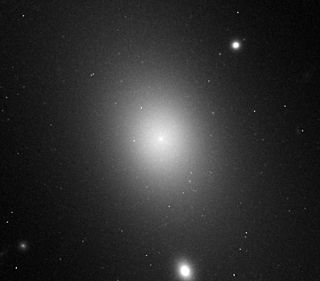
IC 1101 is a class S0 supergiant (cD) lenticular galaxy at the center of the Abell 2029 galaxy cluster. It has an isophotal diameter at about 123.65 to 169.61 kiloparsecs. It possesses a diffuse core which is the largest known core of any galaxy to date, and contains a supermassive black hole, one of the largest discovered. IC 1101 is located at 354.0 megaparsecs from Earth. It was discovered on 19 June 1790, by the British astronomer William Herschel.
In astrophysics and particle physics, self-interacting dark matter (SIDM) is an alternative class of dark matter particles which have strong interactions, in contrast to the standard cold dark matter model (CDM). SIDM was postulated in 2000 as a solution to the core-cusp problem. In the simplest models of DM self-interactions, a Yukawa-type potential and a force carrier φ mediates between two dark matter particles. On galactic scales, DM self-interaction leads to energy and momentum exchange between DM particles. Over cosmological time scales this results in isothermal cores in the central region of dark matter haloes.

Hyper-Luminous X-ray source 1, commonly known as HLX-1, is an intermediate-mass black hole candidate located in the lenticular galaxy ESO 243-49 about 290 million light-years from Earth. The mass of its central black hole is estimated to be approximately 20,000 solar masses. The source was discovered at the Institut de Recherche en Astrophysique et Planétologie, Toulouse, France and gained interest from the scientific community because of strong evidence supporting it as an intermediate-mass black hole. HLX-1 is possibly the remnant of a dwarf galaxy that may have been in a galactic collision with ESO 243-49.

A jellyfish galaxy is a type of galaxy found in galaxy clusters. They are characterised by ram pressure stripping of gas from the affected galaxy by the intracluster medium, triggering starbursts along a tail of gas.

ESO 444-46 is a class E4 supergiant elliptical galaxy; the dominant and brightest member of the Abell 3558 galaxy cluster around 195 megaparsecs away in the constellation Centaurus. It lies within the core of the massive Shapley Supercluster, one of the closest neighboring superclusters. It is one of the largest galaxies in the local universe, and possibly contains one of the most massive black holes known. The black hole's mass is very uncertain, with estimates ranging from as low as 501 million M☉, to as high as 77.6 billion M☉.

NGC 708 is an elliptical galaxy located 240 million light-years away in the constellation Andromeda and was discovered by astronomer William Herschel on September 21, 1786. It is classified as a cD galaxy and is the brightest member of Abell 262. NGC 708 is a weak FR I radio galaxy and is also classified as a type 2 Seyfert galaxy.

NGC 545 is a lenticular galaxy located in the constellation Cetus. It is located at a distance of about 250 million light years from Earth, which, given its apparent dimensions, means that NGC 545 is about 180,000 light years across. It was discovered by William Herschel on October 1, 1785. It is a member of the Abell 194 galaxy cluster and is included along with NGC 547 in the Atlas of Peculiar Galaxies.

ESO 383-76 is an elongated, X-ray luminous supergiant elliptical galaxy, residing as the dominant, brightest cluster galaxy (BCG) of the Abell 3571 galaxy cluster, the sixth-brightest in the sky at X-ray wavelengths. It is located at the distance of 200.6 megaparsecs from Earth, and is possibly a member of the large Shapley Supercluster. With a diameter of about 540.89 kiloparsecs, it is one of the largest galaxies known. It also contains a supermassive black hole, one of the most massive known.

Grant Tremblay is an American astrophysicist notable for research on supermassive black holes, science communication, and public advocacy for large space telescopes. He is currently an Astrophysicist at the Harvard-Smithsonian Center for Astrophysics, and was formerly a NASA Einstein Fellow at Yale University, a Fellow at the European Southern Observatory (ESO), and an Astronomer at ESO's Very Large Telescope (VLT).

IC 4141 is a spiral galaxy in the constellation of Coma Berenices. The galaxy is located 900 million light-years away from Earth. Discovered in 1904 by German astronomer Max Wolf, it measures 255,000 light-years across in diameter. With a radial velocity of 19,000 kilometers per second, it is slowly drifting from the Solar System.
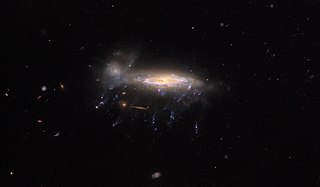
PGC 29820 is a spiral galaxy located 600 million light-years away from the Solar System in the Sextans constellation. The galaxy is about 120,000 light-years in diameter and is a member of Abell 957, a low-mass galaxy cluster. The first known reference to this galaxy is from volume I of the Catalogue of Galaxies and of Clusters of Galaxies compiled by Fritz Zwicky in 1961, where it was listed as CGCG 008-077.

PGC 65543, is a spiral galaxy, with extensive star forming regions, located in Indus. It is 650 million light-years away from the Solar System and approximately measuring 90,000 light-years in diameter. The tidal interactions from certain galaxies which PGC 65543 is moving towards to, have caused it to get distorted. Its star-forming gas and dust are dynamically stripped by ram-pressure and formed into tendrils that stretch outwards, thus gives an appearance of a jellyfish galaxy.
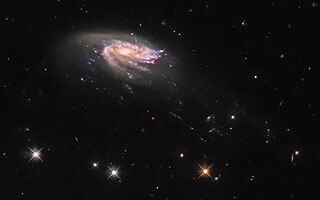
PGC 1228197 known as WINGS J211347.41+022834.9 and JO206, is a large spiral galaxy located 700 million light-years away towards the constellation of Aquarius. The galaxy is estimated to be at least 160,000 light-years in diameter, making it somehow bigger than the Milky Way. With a radial velocity of 15,226 kilometers per second, it is slowly drifting away.

IC 64 is a massive lenticular galaxy located 622 million light-years away in the Pisces constellation. IC 64 has a diameter of 300,000 light-years, making it, three times bigger than the Milky Way and one of the largest galaxies observed. IC 64 was discovered by French astronomer Stephane Javelle on 5 December 1893. It has an active galactic nucleus, and is an emission line galaxy.
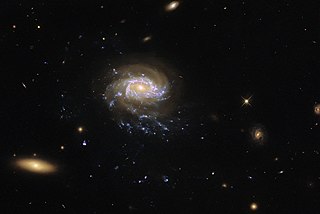
PGC 2456 known as KAZ 364 and JO201, is a spiral galaxy located in the constellation of Cetus. It is located 617 million light-years away from the Solar System. A member of Abell 85, PGC 2456 lies 360 kiloparsecs from the brightest cluster galaxy, Holmberg 15A.

IC 1182 is a type S0-a lenticular galaxy located in Hercules. It is located 464 million light-years away from the Solar System and was discovered on August 11, 1892, by Stephane Javelle. IC 1198 is a member of the Hercules Cluster, which is a part of the CfA 2 Great Wall.

Abell 68 is massive and rich galaxy cluster located in the constellation of Pisces with a projected co-moving distance of approximately 1124.6 Mpc or 3.668 billion light-years away from Earth. The cluster is especially notable for its gravitational lensing and was first discovered by George O. Abell in 1958.

NGC 5419 is a large elliptical galaxy in the constellation of Centaurus. Its velocity with respect to the cosmic microwave background is 4,375 ± 23 km/s, which corresponds to a Hubble distance of 64.5 ± 4.5 Mpc. It was discovered by British astronomer John Herschel on 1 May 1834.


















